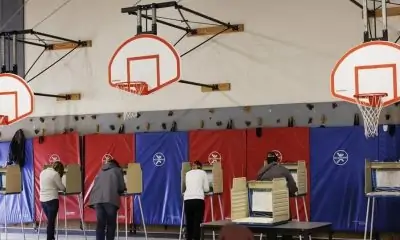Health
Fitness: Has high-intensity interval training been oversold?

High-intensity interval training (HIIT) took the No. 1 spot on the American College of Sports Medicine’s annual Worldwide Survey of Fitness Trends for the first time in 2014 and has stayed in the top 10 ever since. It’s the darling of the fitness world, and there seems to be little that HIIT can’t do.
“HIIT started to gain traction at an astonishing rate and became this major global phenomenon,” said Ekkekakis, who claims there are roughly 700 published studies a year on HIIT.
In the early days, HIIT was considered more appropriate for athletes and the very fit, but it wasn’t long before fitness experts were suggesting it might prove valuable for the average Joe and Jill. Exercise psychologists like Ekkekakis were doubtful.
To gain the much-ballyhooed benefits of HIIT workouts, you need to train at 85 to 95 per cent of your maximum effort (peak heart rate), which isn’t for everyone. The no-pain, no-gain philosophy of exercise has always been embraced by the few, not the masses. Despite this, researchers started publishing data suggesting HIIT is not only well tolerated by average exercisers, they actually find it more enjoyable than less intense workouts.
The combination of enjoyment with the promise of significant results in less time is the holy grail in terms of exercise adherence. Lack of time has been cited as one of the main reasons so few people exercise on a regular basis.
“It’s a lot more complicated than that,” he said of why the exercise dropout rate is so high. “Most people have discretionary time — they just choose not to allocate that discretionary time to exercise, presumably because they find other things that make them feel better or give them more satisfaction.”
Citing a preponderance of evidence proving that intensity drives people away, Ekkekakis decided to take a closer look at HIIT’s track record for long-term adherence. The results were published in a recent edition of Psychology of Sport and Exercise. Along with colleague Stuart Biddle from the University of Southern Queensland, Australia, Ekkekakis identified eight quality studies comparing HIIT to moderate-intensity exercise, all of which included followups of at least 12 months. What they found is unlikely to make HIIT fans happy.
Not all the study subjects gave up exercise altogether — some just weren’t as motivated to sustain the same intensity on their own as when they were under the watchful eye of an instructor. They took the workouts down a notch or two into a more comfortable, moderate-intensity range. That’s not a bad thing — it’s just that when combined with the short duration of most prescribed HIIT workouts, health and fitness benefits are likely to be less significant than advertised.
It turns out gauging exercise enjoyment is harder than you might think. People are in no condition to answer questions about how they feel while in the middle of a tough workout. Any inquiries need to wait until after the workout is over. With all the hard work done and most people feeling accomplished with their efforts, their feelings are much different than when they were in full sweat mode.
“After exercise, almost everyone feels good,” Ekkekakis agreed. “But they might feel good because the darn thing is done.”
Does that mean HIIT has been oversold as a solution to sedentary habits? Probably. But that doesn’t make it a bad option. It’s just not for everyone, which puts it on par with most other workouts. The gauge of an effective workout isn’t how successful it is in a lab, but whether you want to do it all over again on your own.
Health
What’s the greatest holiday gift: lips, hair, skin? Give the gift of great skin this holiday season

|
Give the gift of great skin this holiday season Skinstitut Holiday Gift Kits take the stress out of gifting Toronto, October 31, 2024 – Beauty gifts are at the top of holiday wish lists this year, and Laser Clinics Canada, a leader in advanced beauty treatments and skincare, is taking the pressure out of seasonal shopping. Today, Laser Clincs Canada announces the arrival of its 2024 Holiday Gift Kits, courtesy of Skinstitut, the exclusive skincare line of Laser Clinics Group. In time for the busy shopping season, the limited-edition Holiday Gifts Kits are available in Laser Clinics locations in the GTA and Ottawa. Clinics are conveniently located in popular shopping centers, including Hillcrest Mall, Square One, CF Sherway Gardens, Scarborough Town Centre, Rideau Centre, Union Station and CF Markville. These limited-edition Kits are available on a first come, first served basis. “These kits combine our best-selling products, bundled to address the most relevant skin concerns we’re seeing among our clients,” says Christina Ho, Senior Brand & LAM Manager at Laser Clinics Canada. “With several price points available, the kits offer excellent value and suit a variety of gift-giving needs, from those new to cosmeceuticals to those looking to level up their skincare routine. What’s more, these kits are priced with a savings of up to 33 per cent so gift givers can save during the holiday season. There are two kits to select from, each designed to address key skin concerns and each with a unique theme — Brightening Basics and Hydration Heroes. Brightening Basics is a mix of everyday essentials for glowing skin for all skin types. The bundle comes in a sleek pink, reusable case and includes three full-sized products: 200ml gentle cleanser, 50ml Moisture Defence (normal skin) and 30ml1% Hyaluronic Complex Serum. The Brightening Basics kit is available at $129, a saving of 33 per cent. Hydration Heroes is a mix of hydration essentials and active heroes that cater to a wide variety of clients. A perfect stocking stuffer, this bundle includes four deluxe products: Moisture 15 15 ml Defence for normal skin, 10 ml 1% Hyaluronic Complex Serum, 10 ml Retinol Serum and 50 ml Expert Squalane Cleansing Oil. The kit retails at $59. In addition to the 2024 Holiday Gifts Kits, gift givers can easily add a Laser Clinic Canada gift card to the mix. Offering flexibility, recipients can choose from a wide range of treatments offered by Laser Clinics Canada, or they can expand their collection of exclusive Skinstitut products.
|
||
|
Brightening Basics 2024 Holiday Gift Kit by Skinstitut, available exclusively at Laser Clincs Canada clinics and online at skinstitut.ca. |
||
|
Hydration Heroes 2024 Holiday Gift Kit by Skinstitut – available exclusively at Laser Clincs Canada clinics and online at skinstitut.ca. |
Health
Here is how to prepare your online accounts for when you die

LONDON (AP) — Most people have accumulated a pile of data — selfies, emails, videos and more — on their social media and digital accounts over their lifetimes. What happens to it when we die?
It’s wise to draft a will spelling out who inherits your physical assets after you’re gone, but don’t forget to take care of your digital estate too. Friends and family might treasure files and posts you’ve left behind, but they could get lost in digital purgatory after you pass away unless you take some simple steps.
Here’s how you can prepare your digital life for your survivors:
Apple
The iPhone maker lets you nominate a “ legacy contact ” who can access your Apple account’s data after you die. The company says it’s a secure way to give trusted people access to photos, files and messages. To set it up you’ll need an Apple device with a fairly recent operating system — iPhones and iPads need iOS or iPadOS 15.2 and MacBooks needs macOS Monterey 12.1.
For iPhones, go to settings, tap Sign-in & Security and then Legacy Contact. You can name one or more people, and they don’t need an Apple ID or device.
You’ll have to share an access key with your contact. It can be a digital version sent electronically, or you can print a copy or save it as a screenshot or PDF.
Take note that there are some types of files you won’t be able to pass on — including digital rights-protected music, movies and passwords stored in Apple’s password manager. Legacy contacts can only access a deceased user’s account for three years before Apple deletes the account.
Google takes a different approach with its Inactive Account Manager, which allows you to share your data with someone if it notices that you’ve stopped using your account.
When setting it up, you need to decide how long Google should wait — from three to 18 months — before considering your account inactive. Once that time is up, Google can notify up to 10 people.
You can write a message informing them you’ve stopped using the account, and, optionally, include a link to download your data. You can choose what types of data they can access — including emails, photos, calendar entries and YouTube videos.
There’s also an option to automatically delete your account after three months of inactivity, so your contacts will have to download any data before that deadline.
Facebook and Instagram
Some social media platforms can preserve accounts for people who have died so that friends and family can honor their memories.
When users of Facebook or Instagram die, parent company Meta says it can memorialize the account if it gets a “valid request” from a friend or family member. Requests can be submitted through an online form.
The social media company strongly recommends Facebook users add a legacy contact to look after their memorial accounts. Legacy contacts can do things like respond to new friend requests and update pinned posts, but they can’t read private messages or remove or alter previous posts. You can only choose one person, who also has to have a Facebook account.
You can also ask Facebook or Instagram to delete a deceased user’s account if you’re a close family member or an executor. You’ll need to send in documents like a death certificate.
TikTok
The video-sharing platform says that if a user has died, people can submit a request to memorialize the account through the settings menu. Go to the Report a Problem section, then Account and profile, then Manage account, where you can report a deceased user.
Once an account has been memorialized, it will be labeled “Remembering.” No one will be able to log into the account, which prevents anyone from editing the profile or using the account to post new content or send messages.
X
It’s not possible to nominate a legacy contact on Elon Musk’s social media site. But family members or an authorized person can submit a request to deactivate a deceased user’s account.
Passwords
Besides the major online services, you’ll probably have dozens if not hundreds of other digital accounts that your survivors might need to access. You could just write all your login credentials down in a notebook and put it somewhere safe. But making a physical copy presents its own vulnerabilities. What if you lose track of it? What if someone finds it?
Instead, consider a password manager that has an emergency access feature. Password managers are digital vaults that you can use to store all your credentials. Some, like Keeper,Bitwarden and NordPass, allow users to nominate one or more trusted contacts who can access their keys in case of an emergency such as a death.
But there are a few catches: Those contacts also need to use the same password manager and you might have to pay for the service.
___
Is there a tech challenge you need help figuring out? Write to us at onetechtip@ap.org with your questions.
Health
Pediatric group says doctors should regularly screen kids for reading difficulties

The Canadian Paediatric Society says doctors should regularly screen children for reading difficulties and dyslexia, calling low literacy a “serious public health concern” that can increase the risk of other problems including anxiety, low self-esteem and behavioural issues, with lifelong consequences.
New guidance issued Wednesday says family doctors, nurses, pediatricians and other medical professionals who care for school-aged kids are in a unique position to help struggling readers access educational and specialty supports, noting that identifying problems early couldhelp kids sooner — when it’s more effective — as well as reveal other possible learning or developmental issues.
The 10 recommendations include regular screening for kids aged four to seven, especially if they belong to groups at higher risk of low literacy, including newcomers to Canada, racialized Canadians and Indigenous Peoples. The society says this can be done in a two-to-three-minute office-based assessment.
Other tips encourage doctors to look for conditions often seen among poor readers such as attention-deficit hyperactivity disorder; to advocate for early literacy training for pediatric and family medicine residents; to liaise with schools on behalf of families seeking help; and to push provincial and territorial education ministries to integrate evidence-based phonics instruction into curriculums, starting in kindergarten.
Dr. Scott McLeod, one of the authors and chair of the society’s mental health and developmental disabilities committee, said a key goal is to catch kids who may be falling through the cracks and to better connect families to resources, including quicker targeted help from schools.
“Collaboration in this area is so key because we need to move away from the silos of: everything educational must exist within the educational portfolio,” McLeod said in an interview from Calgary, where he is a developmental pediatrician at Alberta Children’s Hospital.
“Reading, yes, it’s education, but it’s also health because we know that literacy impacts health. So I think that a statement like this opens the window to say: Yes, parents can come to their health-care provider to get advice, get recommendations, hopefully start a collaboration with school teachers.”
McLeod noted that pediatricians already look for signs of low literacy in young children by way of a commonly used tool known as the Rourke Baby Record, which offers a checklist of key topics, such as nutrition and developmental benchmarks, to cover in a well-child appointment.
But he said questions about reading could be “a standing item” in checkups and he hoped the society’s statement to medical professionals who care for children “enhances their confidence in being a strong advocate for the child” while spurring partnerships with others involved in a child’s life such as teachers and psychologists.
The guidance said pediatricians also play a key role in detecting and monitoring conditions that often coexist with difficulty reading such as attention-deficit hyperactivity disorder, but McLeod noted that getting such specific diagnoses typically involves a referral to a specialist, during which time a child continues to struggle.
He also acknowledged that some schools can be slow to act without a specific diagnosis from a specialist, and even then a child may end up on a wait list for school interventions.
“Evidence-based reading instruction shouldn’t have to wait for some of that access to specialized assessments to occur,” he said.
“My hope is that (by) having an existing statement or document written by the Canadian Paediatric Society … we’re able to skip a few steps or have some of the early interventions present,” he said.
McLeod added that obtaining specific assessments from medical specialists is “definitely beneficial and advantageous” to know where a child is at, “but having that sort of clear, thorough assessment shouldn’t be a barrier to intervention starting.”
McLeod said the society was partly spurred to act by 2022’s “Right to Read Inquiry Report” from the Ontario Human Rights Commission, which made 157 recommendations to address inequities related to reading instruction in that province.
He called the new guidelines “a big reminder” to pediatric providers, family doctors, school teachers and psychologists of the importance of literacy.
“Early identification of reading difficulty can truly change the trajectory of a child’s life.”
This report by The Canadian Press was first published Oct. 23, 2024.
-

 News21 hours ago
News21 hours agoVoters back Nebraska’s ban on abortions after 12 weeks of pregnancy and reject a competing measure
-

 News22 hours ago
News22 hours agoJustin Trudeau congratulates Donald Trump on his U.S. presidential win
-

 News21 hours ago
News21 hours agoFinal day for candidate nominations in Nova Scotia election campaign
-

 Real eState21 hours ago
Real eState21 hours agoGreater Toronto home sales jump in October after Bank of Canada rate cuts: board
-

 Economy21 hours ago
Economy21 hours agoTrump’s victory sparks concerns over ripple effect on Canadian economy
-

 News22 hours ago
News22 hours agoCanadanewsmedia news November 06, 2024: Trump declares victory and secures comeback
-

 News21 hours ago
News21 hours agoMurder-suicide in Cole Harbour, N.S., was intimate partner violence, police say
-

 News8 hours ago
News8 hours agoTrudeau, Freeland embrace a second Trump presidency |





















